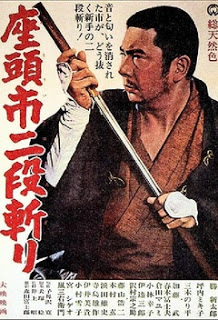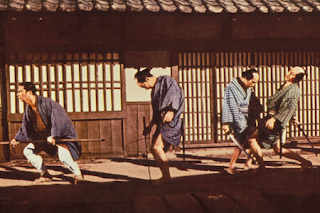Zatoichi - The First Five
Films
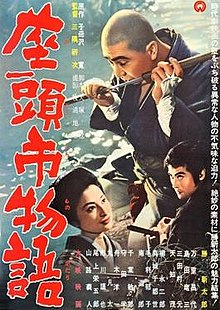
The Tale of Zatoichi (1962) – 7/10
Director: Kenji Misumi
Zatoichi the Blind Swordsman was for many
years one of the most beloved film characters ever in Japan. So much so that
film studio Daiei produced 19 of them and Toho 6 between 1962 until 1973,
when it morphed into a TV show for 4 years with 100 episodes. One later film
was made in 1989. All of these starred Shintaro Katsu as Zatoichi. Shintaro
was a legend both on and off the screen. For 20 years, he was one of the
top pulp actors of his time generally showing up in both Samurai and Yakuza
films – many times playing the bad guy which his rough looks made him a natural
for. He was notorious for his life off the screen as well with numerous run
ins with drinking, drugs, women and general mayhem. He was also a brilliant
swordsman and much of what you see is Shintaro doing all his own swordplay.
Another series he was in later on was the amazing Hanzo the Razor that was
only three films but are well worth watching if only for the penis exercises
such as lifting a load of bricks with said instrument. I would guess that
wasn’t really Shintaro doing that. And I would not try it at home.
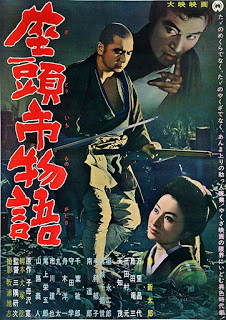
Zatoichi takes place in the Edo period
– I would guess in the early 1800’s - guns had been invented but are very
rare – thus nearly all the action is with sword. He is an itinerant blind
masseur travelling from small town to small town all over Japan. He is part
of what they called the Gangster class or Yakuza but not affiliated with
any particular group. His status was at the very bottom. A Ronin of sorts
but he was never a Samurai. Due to his blindness, he has gained astonishing
sensory and perceptive abilities – sort of like Daredevil who possibly was
modeled on Zatoichi. He loves to gamble, sleep, drink, indulge in prostitutes
and prefers staying out of trouble when he can. He is also an expert swordsman
who fights with all his senses but sight of course.
But trouble is one thing Zatoichi cannot
stay out of – it follows him like his own bad luck shadow. Wherever he goes
he finds trouble – either in the touch of a beautiful woman, the anger of
the gamblers who lost to him (his ears are so sharp they give him an advantage
in dice games), the entreaty of a friend in need or simply because someone
wants him dead. By the time he leaves town there is usually a swath of dead
bodies left behind and a woman waving goodbye. Though a self-confessed gangster
Zatoichi lives by a strict and honorable code of ethics in which he will
side with the downtrodden, respect his friends, honor tradition and exact
revenge if needed of those who break the code of the Yakuza or mess with
him. Because of his blindness, he is constantly underestimated and scorned
by many until they are on the wrong end of a sharp sword.
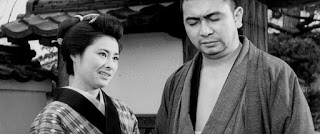
Many of the films have this same general
narrative but within all the films is woven other dramatic stories of personal
conflicts, conspiracies, ambitions, love and murder that eventually entangles
Zatoichi and forces him to reluctantly pull out his sword again. The production
values in the films are terrific with the first two shot in black and white
before they turned to color and the historical settings and designs feel
authentic. I watched a bunch of them years ago, but am planning to slowly
watch them all in order. A tall order. I have gotten through the first two
and they reminded me just how much I liked these films.
In The Tale of Zatoichi (1962), he stops
in a village because someone who had witnessed his sword prowess told him
that he could come visit any time he wants. Turns out his host is a gambler
boss who wants to use Zatoichi in an attempt to destroy another gambling
syndicate. Zatoichi isn’t so eager especially after he meets an honorable
Samurai dying of consumption who is fighting on the other side. Fate brings
them inevitably together in battle.
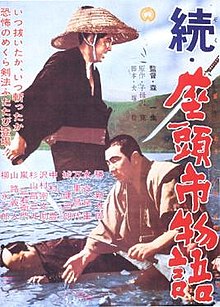
The Tale of Zatoichi Continues (1962) –
7/10
Director: Kazuo Mori
The Tale of Zatoichi Continues – second
in the series - brings Zatoichi back to the same village one year later to
pay his respects to the dead. Trouble follows him again as the old gang leader
feels he has unfinished business with Zatoichi – killing him. Zatoichi has
other ideas but finds more trouble when he runs into his brigand brother
who wants to kill him also. His brother in the film is played by his real-life
brother Tomisaburo Wakayama who was also a renowned action actor of the time
starring in two future series that are terrific – The Wicked Priest and the
classic Lone Wolf and Cub series that was produced by Shintaro. As the series
progresses so does the body count and there are action set pieces in which
Zatoichi takes on dozens of men and dispatches them with his cane sword and
unorthodox style in such swift movements that the blade is but a blur.
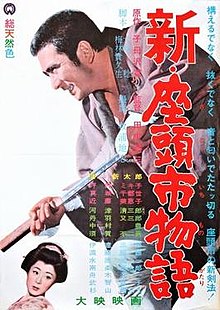
New Tale of Zatoichi (1963) – 7/10
Director: Tokuzo Tanaka
This third film in the series bursts into
color (the first 2 are in black and white), but it sinks into gloom and darkness
as Zatoichi faces his toughest challenge yet - not men with swords - but
who does he want to be. Fate of course settles that question.
He returns to his home town after 4 years
of being on the road. Tagging along on his tracks are a group of men who
want to avenge someone that Zatoichi killed in the prior film. This plays
out quite nicely and honorably.
He visits his sensei, the man who taught
him swordsmanship, and his sensei's sister Yayoi who clearly has a soft spot
for Zatoichi. Much of the film almost plays out like a Ozu family drama of
manners and societal prejudices - Zatoichi as a blind masseur has no status
at all in the hierarchy of either the Yakuza or of society in general - his
standing in life denotes who he is and who he can be and even his sword can't
change this equation - but it can mete out justice. Not a lot of action in
this one till near the end, but an interesting addition to the series in
showing some of his background and character.
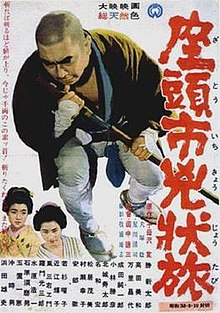
Zatoichi the Fugitive (1963) – 8/10
Director: Tokuzo Tanaka
Zatoichi really hits its stride in this
fourth film in the series. Perhaps the popularity of the series allowed them
to have a much bigger budget and they use it for a film that just feels bigger
and more colorful.
As usual Zatoichi is in another town but
it is the same story - trouble follows him like a shrouded ghost of fallen
victims. It is festival time and Zatoichi gleefully enters into a sumo wrestling
match that he wins - but then someone comes to kill him for the reward that
has been put on his head. Zatoichi almost regretfully kills him because he
realizes the man has no sword skills. In his honorable way he makes his way
to the man's mother to apologize and by doing so he enters into a convoluted
story of numerous narrative threads that all lead to Zatoichi.
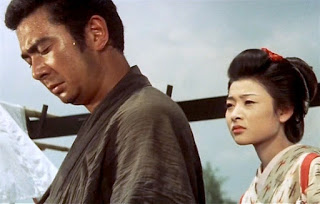
Into this mix is a sort of Romeo and Juliet
angle, a large gang of Yakuza that want revenge for the man that Zatoichi
killed and a brutish Ronin who wants Zatoichi dead for reasons of his own.
Zatoichi also meets up with Tane (Masayo Banri) who he had met in the first
two films of the film but had left her behind to marry a good man. The film
makes it seem as if a fair amount of time has passed since then as she has
fallen on bad times - as she says like a kite with no string going from man
to man. Zatoichi replies "life's dirt sticks to all of us". Tension slowly
builds until it is released in a torrent of blood at the end as Zatoichi
takes it on his own to settle everything - and as many of these films end
- he wanders down the road with a wave of goodbye, a sense of never belonging
and dead bodies littering the landscape.
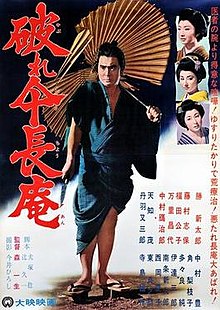
Zatoichi on the Road (1963) – 6/10
Director: Kimiyoshi Yasuda
If I lived in a town back in Japan at this
time and I heard Zatoichi was in town, I would immediately pack a small bag
and go visit relatives far far away because you know by the time Zatoichi
leaves town it will be covered in corpses. Once again Zatoichi is minding
his own business happily eating well and traveling as usual when first three
samurais try and kill him much to their bad luck - then a dying old man pleads
with Zatoichi to take care of Mitsui. Ok - sure why not - except Mitsui just
stabbed some big lord when he tried to rape her and his whole kingdom is
out to kill her. Throw in two warring Yakuza gangs who both want to draft
Zatoichi to their side and you have lots of opportunities for mayhem and
you get plenty here.
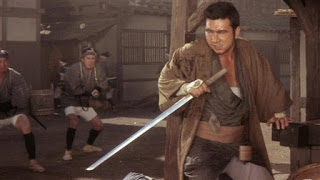
By the fifth film this theme is starting
to get a bit formulaic and certainly the rate of the production of the films
doesn’t help - but there is a certain undeniable pleasure in watching Zatoichi
cut his way through armies of men and in the end waving good bye to the girl.






